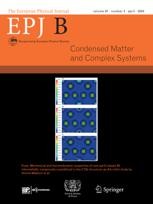Unlocking next-gen optoelectronic with InSb-WSSe heterostructures
Alternating layers of the 2D semiconductors could yield materials with advanced optical absorption properties—especially in the visible range
New York | Heidelberg, 22 August 2025
 Due to their unique geometries and quantum properties, atom-thick 2D semiconductors have transformed the landscape of materials science, placing them at the forefront of fields including electronics, photonics, and energy conversion. Recently, these capabilities have been extended by stacking different 2D semiconductors into van der Waals heterostructures, which exhibit light-detecting and controlling abilities not seen in bulk materials.
Due to their unique geometries and quantum properties, atom-thick 2D semiconductors have transformed the landscape of materials science, placing them at the forefront of fields including electronics, photonics, and energy conversion. Recently, these capabilities have been extended by stacking different 2D semiconductors into van der Waals heterostructures, which exhibit light-detecting and controlling abilities not seen in bulk materials.
In new research published in EPJ B, Weibin Zhang and colleagues at Yunnan Normal University demonstrate that heterostructures made from alternating layers of InSb and WSSe are highly suited for light absorption. If confirmed experimentally, these properties could make the material a valuable platform for harvesting light across a broad range of wavelengths—potentially paving the way for next-generation optoelectronic devices.
Among 2D semiconductors, transition metal dichalcogenides (TMDs) are particularly promising for optoelectronic applications. This is due to their ability to support direct transitions between conduction and valence bands via light absorption and emission. A notable example is WSSe, a ‘Janus monolayer’ in which sulphur and selenium atoms are positioned on opposite sides of a single atomic layer. This asymmetry creates an intrinsic electric dipole not present in conventional TMDs. In parallel, InSb is known for its distinctive physical and electronic properties, making it valuable for infrared detection and thermoelectric conversion.
Using first-principles calculations, Zhang’s team studied the optoelectronic properties of InSb/WSSe van der Waals heterostructures. When properly configured, the combination enables efficient charge transfer between layers, generating a strong built-in electric field. As a result, the heterostructure’s optical absorption is significantly enhanced across the infrared, visible, and near-ultraviolet regions. Peak absorption occurs in the visible spectrum, where it improves by over 44% compared to either monolayer alone. The researchers hope their findings will provide a solid theoretical foundation for future experiments—bringing the practical use of these heterostructures one step closer.
Reference: Su, S., Zhao, X., Wang, X. et al. Study on the electronic structure and optical properties of InSb/WSSe van der Waals heterostructure. Eur. Phys. J. B 98:132 (2025). https://doi.org/10.1140/epjb/s10051-025-00987-2
Further Information
For more information visit: www.epj.org
Services for Journalists
The full-text article is available here.
Contact
Sabine Lehr | Springer | Physics Editorial Department
tel +49-6221-487-8336 | sabine.lehr@springer.com
